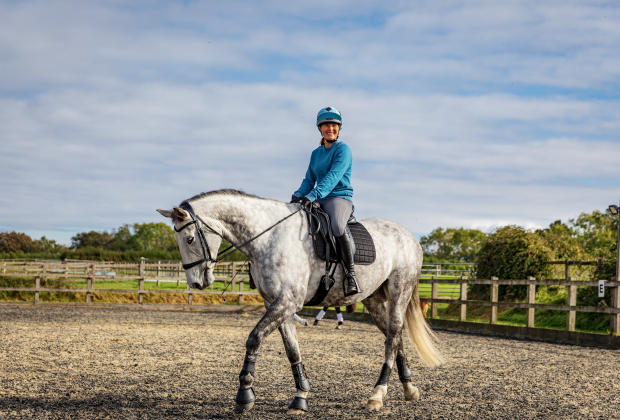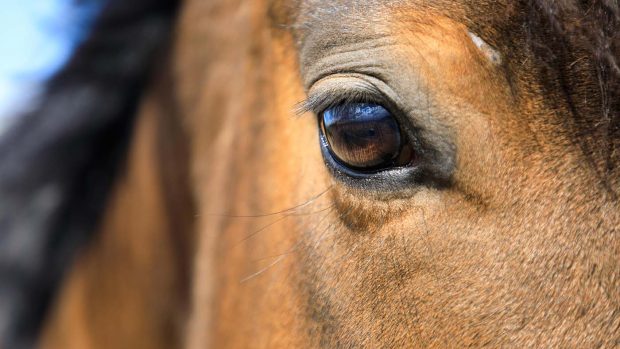Equine back pain is not uncommon and horses are often referred to physiotherapy for assessment and treatment. There are a multitude of reasons as to why a horse may experience back pain and likewise a variety of presenting signs and signs.
Back pain can be caused by dysfunction in a variety of anatomical tissues (e.g. bone, joint, muscle, ligament, nerve). Pain that originates in the spinal region can be deemed as primary back pain. Back pain can also be a secondary sign of physiological dysfunction elsewhere e.g. hindlimb lameness. In some instances, it can be difficult to establish whether back pain is primary or secondary in nature.
Horses are prey animals and will therefore often not show signs of pain until it is truly significant because this would be a sign of weakness to a predator. Horses may demonstrate pain in a variety of ways including a decline in performance and/or a change in behaviour.
Horse owners often describe some of the following signs from horses experiencing back pain:
● Reluctance to being tacked up
● Loss of enthusiasm for work
● Reduced ability or reluctance to jump
● Appearing ‘cold backed’ or ‘hollowing’ through the back
● Tail swishing
● Reluctance to bend on a circle
● Appearing uncomfortable, stiff or lame behind
Possible contributing factors to consider:
● Conformation – certain conformation traits may predispose a horse to back pain, in particular horses that are excessively long backed, short backed or with a lordotic (hollow-backed) posture.
● Tack – studies have shown that having a saddle on the horse’s back increases the amount of spinal extension or ‘hollowing’, which can contribute to injury. Ensuring optimum saddle fit is an important factor in minimising the risk of back pain and optimising performance.
● Rider – a rider who is unbalanced or who has an asymmetric position (e.g. due to pain, weakness or stiffness themselves) may influence the horse’s comfort and could be a contributing factor to equine back pain. It is often beneficial for the rider to be assessed and if required, physiotherapy input can support improvements to the rider’s comfort and position on the horse too.
● Head and neck position – the horse’s head and neck position influences spinal biomechanics. Ensuring that training encourages the horse to vary its head and neck position (rather than a fixed head carriage) by working the horse through from behind may help support improvements in comfort — both through the horse’s neck and back.
● Underlying pathology – Most back pain will improve with physiotherapy, however if it doesn’t, a veterinarian can investigate further as to whether there is underlying pathology.
A simple way for owners to monitor how comfortable their horse is through the back is to carry out the following palpation techniques:
1. Slowly run your finger tips down the long spinal muscles either side of the horse’s spine from the wither region to the tail.

Run your fingers towards the tail
2. Slowly run your fingertips across the spinal muscle fibres towards the spine and carry this out sequentially along the horses back.

Run your fingers upwards towards the spine
Continued below…
Like this? You might also enjoy reading these:
Nina Wareham’s physiotherapy blog: Factors to consider in optimising horse performance and welfare
Nina Wareham’s physiotherapy blog: 4 key stretches to improve your horse’s core stability
Nina Wareham’s physiotherapy blog: engagement and core strength — why they are important for your horse
Feel for lumps, bumps, heat, and hair changes/chaffing. Signs of discomfort may include, the horse dipping away from your hand, the muscles appearing to tighten or clamp down, muscle fasciculation (appearing to ‘flicker’ under the pressure). Also watch for behavioural signs such as tail swishing or the horse pinning its ears back.
N.b Horses can be unpredictable especially if in pain. Any person carrying out the above technique must do so at his or her own risk. Seek professional advice if you are unsure.
If you are concerned that your horse may have back pain, a vet and/or physiotherapist (following veterinary referral) can further assess and help to establish a likely cause.
Nina





